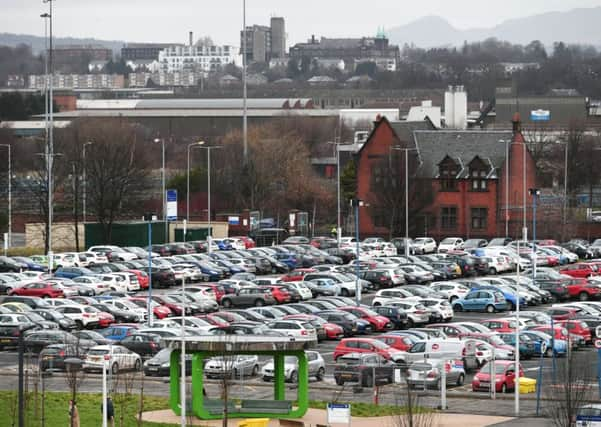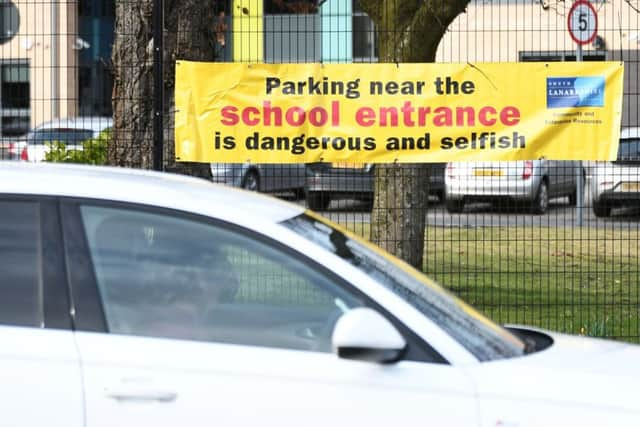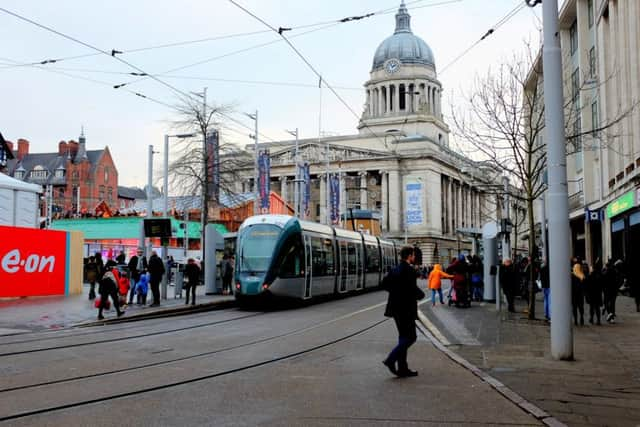Insight: Is the workplace car levy a panacea for urban congestion or a poll tax on wheels?


When Nottingham City Council first announced its plans for a workplace parking levy, the backlash was immediate.
“Lots of businesses were trying to work out ways to get round it,” says BBC Nottingham journalist Rebecca Brice, who covered the story. “I spoke to one employer who was talking about painting huge [bays] in the car park so it looked as if there were only 10 spaces [because 10 is the maximum number allowed before a company must start paying].”
Advertisement
Hide AdAdvertisement
Hide AdUnder Nottingham’s WPL scheme, businesses with 11 or more spaces must pay an annual tax (currently £415 per space); but an estimated 40 per cent of employers have passed the cost on to their workers. “People were initially outraged because they were paying the money, but not seeing the benefits,” says Brice.


Seven years on, however, the city’s WPL scheme is held up as a model and has helped the city win an Ashden Award for sustainable travel.
Under the English legislation, the money collected must be ring-fenced for public transport improvement projects. So far, the revenue – £53m and rising – has helped secure a £570m extension to the tram network, a £60m redevelopment of the city’s railway station and support for the £15m electric Link bus network.
Though the WPL scheme is not without its critics, there has been a 100 per cent compliance rate and no impact on inward investment, and Nottingham’s integrated transport network is now the envy of neighbouring cities.
“It’s noticeable how much easier it is to use the Nottingham Park & Ride tram services compared with our services,” says Michael Gayler, a retired healthcare worker who lives in Leicester. “The trams always seem to be reliable and clean. Bus services in Nottingham appear to run on a much more comprehensive network, compared with Leicester where we have a fragmented and disjointed effective duopoly [First & Arriva with each company dominating one side of the city].”


The WPL scheme may also have helped Nottingham slash its carbon emissions by a third since 2005, allowing it to meet the city council’s 2020 target four years early. So successful has the scheme proved that other places, including Oxford, Cambridge and Bristol, and the London boroughs of Merton, Brent and Camden, look set to follow suit.
In England, the legislation allowing councils to implement such a levy was introduced back in 2000 by Tony Blair’s government. Yet a proposal to introduce similar legislation in Scotland – one of a number of concessions the Greens won to secure their backing for this year’s budget – has caused consternation north of the Border. So fierce was the opposition in some quarters that the topic overshadowed even the tourist tax.
The proposal was branded “an outrage” by Scottish Labour MSP James Kelly despite the fact that it was a Labour government that introduced the legislation in England and Nottingham is a Labour-led council. Willie Rennie also spoke out against it despite it being on the Scottish Liberal Democrats’ manifesto in 2000 and 2003.
Advertisement
Hide AdAdvertisement
Hide AdSome of the opposition has been based on a misunderstanding. Complaints that there were no details about how a WPL would work in practice ignored the fact that, as in England, this legislation would simply grant local authorities the power to act. Edinburgh and Glasgow City Councils are actively considering WPL schemes. Were they to press ahead, the specifics would be up to them.
Other criticism, however, has mirrored that experienced in Nottingham. The AA has claimed that – if passed on from employer to employee – it is a “poll tax on wheels”; others that it discriminates against shift workers and those who live in places poorly served by public transport. Teachers have been particularly vocal, with the EIS warning its members would demand the refund of any charges they were forced to pay.
Another congestion-busting plan announced last week – car-free zones outside seven Glasgow primary schools – met with a similar ambivalence. This time, critics feared the scheme would penalise working parents who travel straight to the office from the school-run and those whose children’s primaries were far from a bus stop or train station.
Both debates illustrate the contradiction at the heart of efforts to cut down on traffic and pollution. While most motorists want to see congestion reduced, they are reluctant to alter their own driving habits. Or – to put it another way – everybody wants the open road to themselves.
Green MSP Andy Wightman believes such attitudes are unsustainable. “The point is that driving cars involves a whole lot of externalities – pollution, inefficient use of urban space and so on – so the users of cars need to be paying a little bit more towards these externalities,” he says.
However, he points out there would be nothing to stop employers exempting low-paid workers from any parking charges they decide to impose. “If I were designing a scheme I would, as a council, be providing incentives for employers to give their workers public transport vouchers.”
But surely, for that to work, the existing public transport system has to be fully integrated and efficient? “It’s a chicken and egg thing. Public transport improvements are easier to implement with a revenue stream than they would be if you were to insist those improvements have to be in place before a WPL can be implemented,” he says.
Nottingham City Council decided to introduce its WPL after studies showed congestion was costing the city £170m a year, with commuters accounting for 70 per cent of congested peak-time traffic.
Advertisement
Hide AdAdvertisement
Hide AdSimilar schemes had proved successful in Australia and Canada, but Nottingham was the first (and so far only) city to implement it here in the UK. The decision was taken to include the whole city (Nottinghamshire County Council, a Tory/Mansfield Independent Forum coalition was not interested in extending it out to more rural areas).
The local authority opted for the WPL as opposed to, say, a congestion charge because it is simpler to administer, with employers managing their own accounts online. As a result only 5 per cent of revenue is spent on managing the scheme.
The WPL revenue is used as local match funding to enable the city council to bid for external funds from the Department of Transport and elsewhere; so, for example, the government agreed to pay 75 per cent of the tram extension if Nottingham City Council paid the remaining 25 per cent.
Revenue from the WPL has also contributed towards the development of Nottingham’s integrated all-operator, pay-as-you-go smartcard, its real-time information system with over 1,500 displays, two refurbished bus stations and technology for priority and late running buses at key junctions.
“We have always been at the forefront of a public transport network,” says Nottingham City Council leader Jon Collins. “We still own our own bus companies. And we had secured the funding to build line one of the tram system, which had been a success. We wanted to extend the tram network and this was the most effective way of funding it.
“Nobody likes paying extra for anything, but the most important point from our perspective was being very clear that the money raised was to improve public transport and that it was the improved public transport that gave people options not to use the car and travel in a way that eased congestion.”
Being the first of its kind, Nottingham’s WPL scheme has not been without its teething problems. One of the principal challenges, particularly in the early days, was that those commuters who were unwilling to pay for parking spaces at work either switched to free on-street parking or left their cars just outside the city boundary in order to hop on a bus, leading to greater congestion at those spots. This has been targeted by making some of those areas residents’-permit-only (with those permits being free).
Chris Norton works for a company which has two offices in Nottingham no more than a mile apart. One introduced parking charges and the other didn’t, which led to resentment. “There were also instances at our office of people trying to avoid paying the levy by parking on streets, including residential roads,” he says. “This caused issues where cars had aggressive and threatening notices left, tyres were slashed and cars were keyed. It also created difficult relations with neighbours, but [the workers] weren’t breaking the law.”
Advertisement
Hide AdAdvertisement
Hide AdNorton believes the WPL causes problems for firms that rely on staff from further afield. “I work for a company that requires people with specialist qualifications and skills who travel to our office from outlying towns and cities like Northampton, Leicester, Derby, Mansfield, and beyond,” he says. “It would take longer and be more expensive to travel by public transport than by car. And then what about ad hoc meetings in the day which require onward travel? Not all locations are serviceable by public transport.
“In a lot of respects, [the WPL] has been a great success, as it puts people on to the trams, takes traffic off the streets and has reduced pollution. Car share schemes are very popular, especially at big employers like Boots. But for people in areas where bus services have been cut back, or who live outside a reasonable commute, it’s a cost incurred for no benefit.”
Hugh McClintock, a committee member of Pedals, says cyclists have benefited from the grants given to many workplaces for cycle parking and shower facilities, but that not enough has yet been invested in initiatives aimed at encouraging more people to cycle.
“Nottingham still has a quite a lot of pollution particularly on the bridges and some of their approaches. Without more radical measures on a comprehensive basis, the benefits are limited,” he says.
However, independent research carried out by Stephen Ison, professor of transport at Loughborough University, found the WPL levy had slowed the growth in the number of cars (though not reversed it), increased the number of people using public transport and made a significant impact on congestion in Nottingham.
“The Loughborough study found Nottingham was doing well economically when you compare it to similar cities in England, so the WPL hasn’t deterred business, but what it has done is improve the transport network quite considerably so people are benefiting,” says Professor Tom Rye, director of Napier University’s Transport Research Institute.
“That’s not just because of the WPL. If you look at the council’s transport department, it has always had inspirational people; people who have been willing to look for new solutions and to put those solutions in place. But the WPL is definitely helping.”
In Scotland, we are still at the point of exploring the terms of the proposed legislation. Wightman says public acceptance of any future scheme will be more likely if ours, like England’s, stipulates revenue must be ring-fenced for transport projects.
Advertisement
Hide AdAdvertisement
Hide AdRye would like to see the charges extended to off-street parking spaces for visitors and shoppers. “In England, the law only allows the levy to be applied to parking spaces for employees – that makes it very complicated and the council has to rely on employers to be honest about how many workers’ spaces they have,” he says.
“I think it would be great if the Scottish Government gave serious consideration to widening this so councils could, if they wished, place a levy on other types of off-street parking. That would make it easier to implement and it could help the competitiveness of city centres because it would be possible to put a levy on out-of-town shopping centres.”
When and if the legislation is introduced here, individual councils could customise their schemes . The Scottish government has already said there would be exemptions for NHS employees, but this could be extended to all emergency workers. And the levy would not need to apply to the entire council area; it could be confined to specific zones.
“Just as with a congestion charge, one of the questions would be: ‘Where do we draw the line?’ and there’s nothing to stop different councils drawing that line in different places. There is nothing to stop North Lanarkshire having a scheme just in Airdrie or Edinburgh having a scheme just in the centre or just in the west,” says Wightman.
The MSP is, as you would expect, enthusiastic. But given the negative response to both the WPL and the pilot of car-free zones round Glasgow schools, does he believe the public is ready to accept measures that make demands on their time and/or their pocket?
“From the evidence of the last couple of weeks, I would say no. But a WPL or curb in parking near schools needs to be part of a strategic plan to reduce car use in urban areas,” he says.
“I think if you asked people if we needed to reduce the reliance on cars most people would say ‘yes’. It’s when you get to the point of ‘what exactly are we going to do?’ that they start factoring in their own personal preferences and those preferences sway their opinions.
“But that is a conversation councils should be having with their electorate. Edinburgh is already having those kinds of conversations and a WPL would further stimulate the debate.”
Advertisement
Hide AdAdvertisement
Hide AdWightman believes the Nottingham experience proves that public transport systems are more likely to improve when there is a catalyst for change.
“In Nottingham, the WPL is changing behaviours of employers, it is changing the behaviour of planning authorities, it is changing the behaviour of business associations, so it is beginning to align a lot more interests in the city with improvements in public transport system.
“While the car has a relatively free reign, the chambers of commerce, employers’ associations and trade unions don’t have the same incentive to lobby for better public transport because their members or employees use cars.
“The minute the car is made just that little bit more difficult, however, you get to a tipping point where people start talking seriously about what can be done to improve things.”